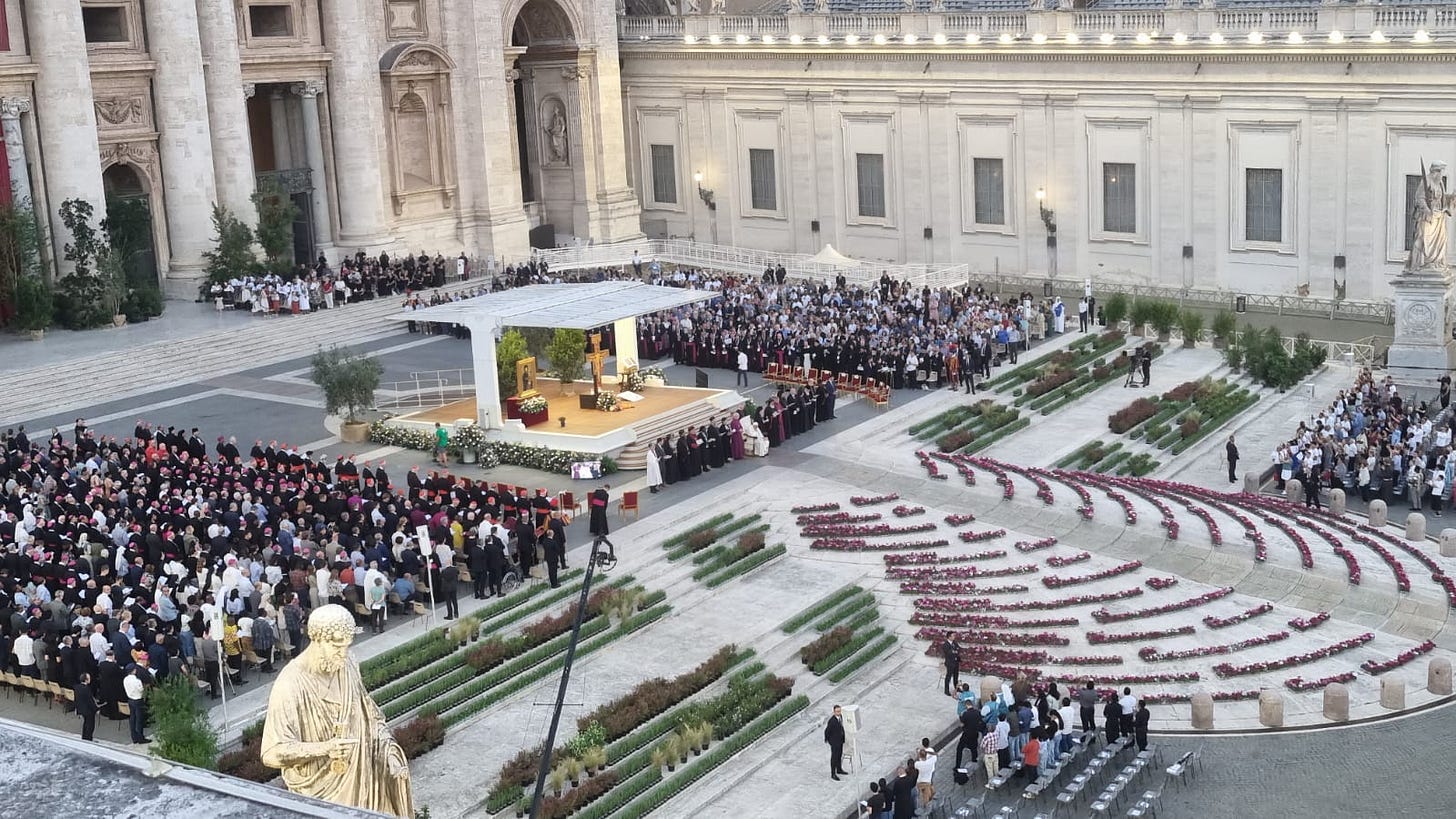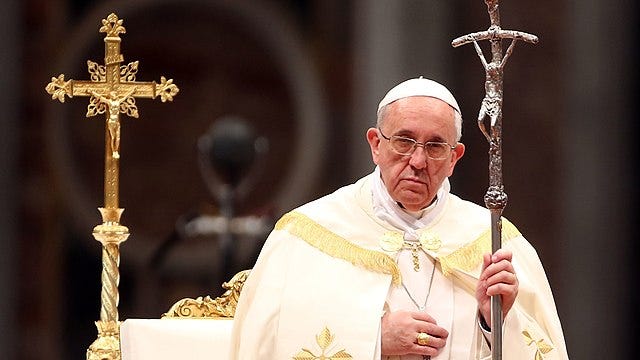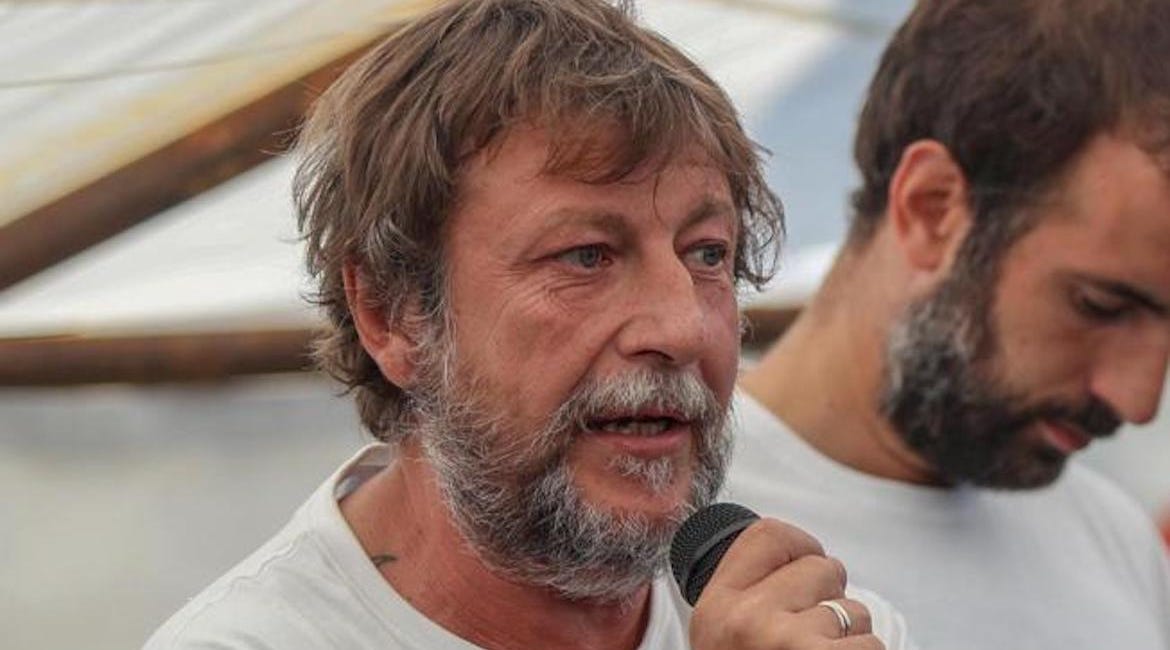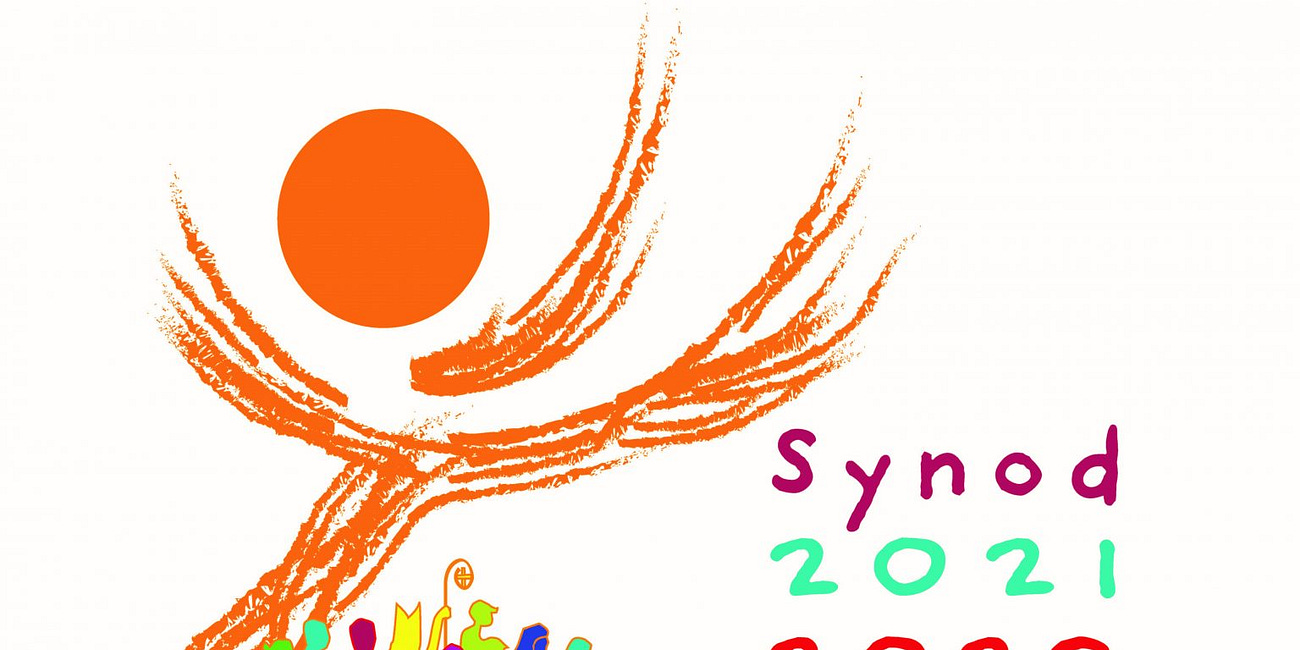Back in July, the Vatican released the list of participants who had been invited to attend the Synod of Bishops in October. Soon after, Catholic media in the United States published profiles of the Americans and Canadians who would be attending the Synod. These were great resources, but they left me wondering, who are the participants from the rest of the world? Of course, a handful of prominent church leaders from abroad may be familiar in the United States, but I was especially interested in learning about the theologians, lay leaders, activists, and more obscure bishops who might have interesting stories or who might bring creative insights to the Synod.
And so began an adventure, the Synod on Synodality World Tour. Why did I do it? For one, I was just curious. Who are the people who will potentially be shaping the agenda for the Catholic Church in the years to come? But second, a key element of the synodal process has been learning to listen to the fellow members of our Church, and so I thought it would be important to listen to what Church members around the world are saying, and to learn what they are contributing to the worldwide synodal process. For that reason, as part of the series, I also read and reflected on the documents written by delegates from each continent (apart from North America). These documents were the fruit of conversations at the parish, diocesan, and national levels, and also responses to the Working Document for the Continental Stage, written by a team at the Vatican.
Several of the articles in the Synod on Synodality World Tour series were for paid subscribers only, but I want everyone to be able to access them and learn from them, so I have made them all available and gathered them here into one resource.
As you look through this resource, I would ask you to consider taking out a subscription to the Window Light newsletter, if you haven’t already. A free subscription will give you immediate access to the newsletter in your email inbox. A paid subscription will give you access to additional, exclusive content. It also helps to support the work that goes into the newsletter, like this series, which took many, many hours to put together. Whether you subscribe or not, however, thank you for reading Window Light!
In July, the Vatican released the names of the participants in October’s Synod of Bishops, and the list was updated in September.
List of the Participants to the XVI General Ordinary Assembly of the Synod of the Bishops
A few days after the list was first published, I wrote about how the Synod on Synodality would fit into Pope Francis’s overall legacy, as well as other initiatives like the reform of the Roman Curia, the appointment of bishops and cardinals, and his teaching documents, most notably Laudato Si’ and Amoris Laetitia.
Cementing Pope Francis's Institutional Legacy
There has been a flurry of Vatican-related news over the past two weeks, including a number of key appointments by Pope Francis: on June 29, Francis blessed the palliums of 32 new archbishops appointed over the past year; on July 1, he appointed Archbishop Victor Manuel Fernández of La Plata, Argentina as the new prefect of the Dicastery for the Doctrin…
North America
The North American continental document was released in April of this year, after the Continental Assembly met at twelve separate Zoom meetings, unique among continental groups. Delegates from each of these teams then reported to the Synod Team, which drafted the document. There were several good analyses of the document, for example, by Michael J. O’Loughlin at America, Gina Christian at Our Sunday Visitor, and Michael Sean Winters at the National Catholic Reporter.
After the list of Synod participants was released in July, Michael J. O’Loughlin surveyed the participants from the United States for America, and Jonathan Liedl offered a similar survey of participants from the United States and Canada for the Catholic News Agency. More recently, Heidi Schlumpf at the National Catholic Reporter has provided a guide to the participants from the United States.
Latin America and the Caribbean
I began the Synod on Synodality World Tour in Latin America and the Caribbean, the continent with which I am probably the most familiar, apart from North America. The Latin American continental document thoroughly embraces synodality and provides an optimistic picture of how it can be lived out in Latin America and the Caribbean. It offers rich theological concepts like its endorsement of “an incarnated and Marian synodal spirituality” (“una espiritualidad sinodal encarnada y mariana”, 45). As I noted in my reflection, however, the regional documents written in preparation for the continental document provide a more realistic picture of the obstacles to living out synodality, like clericalism and social divisions. They also introduce the notion of a “listening deficit” (“deuda de eschucha”), a pointed diagnosis of one of the challenges facing the global Church.
Synod on Synodality World Tour: Latin America and the Caribbean, Part I
This is the first in an occasional series exploring the contributions of different parts of the globe to the upcoming Synod on Synodality in October. Each post will analyze the main themes in the documents from the Continental phase of the synodal process or participants from each continent. This first post looks at key themes from the documents produce…
The Synod delegation from Latin America and the Caribbean is very well-rounded, including some important curial officials, influential bishops, well-respected theologians, and a substantial group of lay leaders. The Synod participants include recently-appointed Prefect of the Dicastery for the Doctrine of the Faith, Victor Manuel Fernández, a religious sister from Nicaragua who promotes evangelization on social media (and who is live-tweeting—er, live-posting?—her experiences at the Synod), another religious sister who runs a shelter for Central American migrants in Mexico, and a Brazilian archbishop known as “the voice of the Amazon,” among many others. In this post, I inadvertently excluded Sr. Rosmery Castañeda Montoya from Colombia, a member of the Dominican Sisters of the Presentation in Panama.
Synod on Synodality World Tour: Latin America and the Caribbean, Part II
This is the second in an occasional series exploring the contributions of different parts of the globe to the upcoming Synod on Synodality in October.
Asia and Oceania
Asia and Oceania (which includes Australia, New Zealand, and the islands of the Pacific) are considered two separate continents for purposes of the synodal process, but I considered them together because their delegations are both relatively small. Both the Asian continental document and the Oceania continental document are relatively brief and less theological compared to the North American and Latin American documents, but both still offer valuable insights into church life on both continents. In my reflections on the two documents, I noted that the Asian document appeals to images of the Church as a mother and as a bridge-builder. Both documents comment on the Church’s need to adapt to the culturally and religiously diverse contexts of the two continents, but they also point to the challenges of being open to the world in societies where there may be divergences between culture and the Gospel.
Synod on Synodality World Tour: Asia and Oceania, Part I
This is the third in an occasional series exploring the contributions of different parts of the globe to the upcoming Synod on Synodality in October. So far on this “world tour” in preparation for the Synod on Synodality in October, I have looked at the
The Synod delegations from Asia and Oceania include a surprising number of cardinals, most of whom were appointed by Pope Francis. They include some leaders considered contenders to be the next pope, like William Goh Seng Chye from Singapore, Lazzaro You Heung-Sik from South Korea, and Luis Antonio Tagle from the Philippines. Also among the cardinals is Giorgio Marengo, I.M.C., the Italian missionary who now leads the tiny Catholic population in Buddhist-majority Mongolia, which Pope Francis recently visited. Other participants from Asia and Oceania include the leader of the Syro-Malabar Catholic Church in India, embroiled in a heated controversy over that Eastern Catholic Church’s liturgy, the lay leader who advises Australia’s bishops on the pastoral and social needs of Australia’s Aboriginal population, a bishop known for providing wheelchairs to the victims of landmines in Cambodia, and several internationally-recognized theologians, among others. Since I wrote my survey of the participants from Asia and Oceania, Pope Francis announced that two bishops from the Chinese mainland would also be joining the Synod: Bishop Joseph Yang Yongqiang of Zhoucun, and Bishop Anthony Yao Shun of Jining.
Synod on Synodality World Tour: Asia and Oceania, Part II
This is the fourth in an occasional series exploring the contributions of different parts of the globe to the upcoming Synod on Synodality in October. Earlier this week, I offered an analysis of the synodal documents drafted by participants in the continental assemblies for Asia and Oceania. The documents drew on images for the Church like “mother,” “bri…
The Middle East
The Middle East continental document is among the most theologically rewarding. It provides a theological reflection on synodality and also explains the Eastern tradition of synodal governance. The document also focuses on the minority status of Christians in the Muslim-majority Middle East (with some exceptions, like Lebanon), describing how this presents challenges to the Church living out synodality, but also urging that Christians resist the temptation of a “minority complex,” or immobility resulting from fear and resignation. The document also explores the rich tapestry of Eastern and Western Christianities in the region.
Synod on Synodality World Tour: The Middle East, Part I
This is the fifth in an occasional series exploring the contributions of different parts of the globe to the upcoming Synod on Synodality in October.
The Middle Eastern delegation to the Synod includes the leaders of several of the Eastern Catholic Churches, including Ibrahim Isaac Sidrak, the head of the Coptic Catholic Church in Egypt, and Cardinal Louis Raphaël I Sako, the head of the Chaldean Catholic Church, who led Iraq’s Christian minority in the midst of the violent conflict with ISIS, but who has more recently been in conflict with Iraq’s democratic government. Several leaders serve different Christian populations in Lebanon. Other delegates include an Italian missionary tasked with caring for the small Catholic population in Oman, United Arab Emirates, and Yemen, and a religious sister who lives in a monastery in the Syrian wilderness who has cared for refugees in that country’s civil war. The Middle East was the continent for which I had the most difficulty identifying delegates. I also inadvertently left out of my survey Maragret Karram from Israel, the president of the worldwide Focolare movement, who had previously been involved in interreligious dialogue in the Holy Land on behalf of the Latin Patriarchate of Jerusalem.
Synod on Synodality World Tour: The Middle East, Part II
This is the sixth in an occasional series exploring the contributions of different parts of the globe to the upcoming Synod on Synodality in October.
Africa
The African continental document is relatively spare, similar to those from Asia and Oceania. It appeals to the image of the Church as a family, an image already developed at two earlier African Synods of Bishops. In this case, the image of the family of God is used to express the notion that every member of the Church has a distinctive role to play in the Church’s mission. The document focuses on inculturation, or the adaptation of the Church’s faith and worship to distinct cultural contexts, as an important dimension of synodality, but also raises concerns—perhaps more strongly than any other continental document—about preserving the truth of the Gospel while remaining open to the world.
Synod on Synodality World Tour: Africa, Part I
This is the seventh in an occasional series exploring the contributions of different parts of the globe to the upcoming Synod on Synodality in October.
The African delegation to the Synod includes a new generation of episcopal leaders mostly unknown in the West but who will wield influence in the Church for years to come. Other notable participants include a bishop almost beheaded by Islamist militants, a radio host from South Africa who will be handling the media at the Synod, an archbishop who plants trees, the first woman with a PhD in theology in Côte d'Ivoire, and a bishop accused of plagiarizing his dissertation, among many others.
Synod on Synodality World Tour: Africa, Part II
This is the eighth in an occasional series exploring the contributions of different parts of the globe to the upcoming Synod on Synodality in October.
Europe
Out of all the continental documents, the European document shows the most evidence of underlying conflicts about the direction of the Catholic Church. The document describes several tensions expressed during the synodal process in Europe, including tensions over the liturgy, tensions over the role of clergy and laity, and tensions over the role of women in the Church’s leadership. The most overarching tensions, however, are those between remaining faithful to the traditions of the Church and being open to the world, and between proclaiming the truths about the human person found in Catholic doctrine and building a merciful and inclusive community. These tensions are not resolved in the document, which calls for the Church to be “kenotic,” or “self-emptying,” willing to let go of certain forms of the past so that new life can emerge.
Synod on Synodality World Tour: Europe, Part I
This is the ninth in an occasional series exploring the contributions of different parts of the globe to the upcoming Synod on Synodality in October.
The Synod delegation from Europe is extremely large, disproportionately so despite Pope Francis’s efforts to “globalize” the Church’s leadership, and so I divided my survey of European participants into three parts. In the first part, I looked at curial officials, Synod organizers, and bishops from Western Europe. Some of the participants discussed include supporters and opponents of the controversial German Synodal Way, the national gathering of Church leaders that recommended revising the Church’s teaching on homosexuality in the Catechism, approval for the blessing of same-sex unions, and a reexamination of the ordination of women. Other participants include the former Prefect of the Congregation (now Dicastery) for the Doctrine of the Faith, Cardinal Gerhard Müller, who has been critical of Pope Francis since the former’s dismissal in 2015, a Spanish cardinal who helped orchestrate the “Human Fraternity for World Peace and Living Together” document signed by Pope Francis and Ahmed el-Tayeb, the Grand Imam of al-Azhar, and an Irish bishop who was connecting people to the Church online as early as the 1990s.
Synod on Synodality World Tour: Europe, Part II
This is the tenth in an occasional series exploring the contributions of different parts of the globe to the upcoming Synod on Synodality in October.
Next, I considered the theologians, lay leaders, and religious brothers and sisters from Western Europe attending the Synod. They include a communist anti-globalization protester who found God on a ship rescuing migrants and is now friends with Pope Francis, experts in canon law, a theologian who got promoted from the theology faculty to being the archbishop of a major see, and the only permanent deacon attending the Synod, among many more.
Synod on Synodality World Tour: Europe, Part III
This is the eleventh in an occasional series exploring the contributions of different parts of the globe to the upcoming Synod on Synodality in October.
The final installment of the Synod on Synodality World Tour series looked at the Synod participants from Eastern Europe. The ongoing war in Ukraine looms large for the Church in this region, and several of the delegates are from Ukraine and have experienced the horrors of war firsthand. The Ukrainian delegates also reflect the rich variety of liturgical and theological traditions in Eastern Europe, and other delegates include leaders of the various Eastern Catholic Churches in the region, as well as bishops from the Latin Church. Other participants include a former atheist and migrant who became the leader of the Church in Albania, a Polish bishop who wants to abolish Halloween, and the cardinal who carried out dangerous humanitarian missions to Ukraine on behalf of the Vatican. I also inadvertently left Jan Nowotnik, the Director of Mission and National Ecumenical Officer for the Catholic bishops of England and Wales, out of my survey. Sr. Christine Danel, X.M.C.J., the superior general of the Congregation of Xavières (the order to which Synod organizer Sr. Nathalie Becquart also belongs) was also recently added to the Synod participants list.
Synod on Synodality World Tour: Europe, Part IV
This is the twelfth and final article in an occasional series exploring the contributions of different parts of the globe to the upcoming Synod on Synodality in October.
The Synod Arrives
Before I began the Synod on Synodality World Tour series, I wrote a commentary on the Instrumentum Laboris, or working document, written as a preparatory guide for the Synod gathering. It provides a summary of the aims of the synodal process, and then provides a series of questions, organized by topic, meant to guide the conversations of Synod participants. The document is therefore quite unlike previous Synod working documents, open-ended rather than proposing a set of conclusions the Synod participants should reach. The Instrumentum Laboris was written in response to the contents of the various continental documents, and unfortunately, I read and commented on it before I had read those continental documents. It might be worth a re-read on my part.
Thoughts on the Synod Instrumentum Laboris
Last week, the Vatican released the Instrumentum Laboris (IL), or working document, on synodality that will guide the discussions at the first of two meetings of the Synod of Bishops this October. The IL is a synthesis of continental documents that were written earlier this year, which in turn were syntheses of documents produced at the diocesan and nat…
I will offer continuing commentary on the Synod as it unfolds, so be sure to subscribe so you won’t miss anything! And thanks for reading! Let me know in the comments if you have any thoughts on the Synod on Synodality World Tour series, or if you have any suggestions on topics related to the Synod you’d like to read about in the newsletter.



















